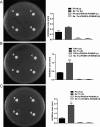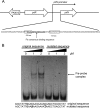Fis Contributes to Resistance of Pseudomonas aeruginosa to Ciprofloxacin by Regulating Pyocin Synthesis
- PMID: 32205461
- PMCID: PMC7221260
- DOI: 10.1128/JB.00064-20
Fis Contributes to Resistance of Pseudomonas aeruginosa to Ciprofloxacin by Regulating Pyocin Synthesis
Abstract
Factor for inversion stimulation (Fis) is a versatile DNA binding protein that plays an important role in coordinating bacterial global gene expression in response to growth phases and environmental stresses. Previously, we demonstrated that Fis regulates the type III secretion system (T3SS) in Pseudomonas aeruginosa In this study, we explored the role of Fis in the antibiotic resistance of P. aeruginosa and found that mutation of the fis gene increases the bacterial susceptibility to ciprofloxacin. We further demonstrated that genes related to pyocin biosynthesis are upregulated in the fis mutant. The pyocins are produced in response to genotoxic agents, including ciprofloxacin, and the release of pyocins results in lysis of the producer cell. Thus, pyocin biosynthesis genes sensitize P. aeruginosa to ciprofloxacin. We found that PrtN, the positive regulator of the pyocin biosynthesis genes, is upregulated in the fis mutant. Genetic experiments and electrophoretic mobility shift assays revealed that Fis directly binds to the promoter region of prtN and represses its expression. Therefore, our results revealed novel Fis-mediated regulation on pyocin production and bacterial resistance to ciprofloxacin in P. aeruginosaIMPORTANCEPseudomonas aeruginosa is an important opportunistic pathogenic bacterium that causes various acute and chronic infections in human, especially in patients with compromised immunity, cystic fibrosis (CF), and/or severe burn wounds. About 60% of cystic fibrosis patients have a chronic respiratory infection caused by P. aeruginosa The bacterium is intrinsically highly resistant to antibiotics, which greatly increases difficulties in clinical treatment. Therefore, it is critical to understand the mechanisms and the regulatory pathways that are involved in antibiotic resistance. In this study, we elucidated a novel regulatory pathway that controls the bacterial resistance to fluoroquinolone antibiotics, which enhances our understanding of how P. aeruginosa responds to ciprofloxacin.
Keywords: Fis; Pseudomonas aeruginosa; pyocin; resistance.
Copyright © 2020 American Society for Microbiology.
Figures





Similar articles
-
PrtR homeostasis contributes to Pseudomonas aeruginosa pathogenesis and resistance against ciprofloxacin.Infect Immun. 2014 Apr;82(4):1638-47. doi: 10.1128/IAI.01388-13. Epub 2014 Feb 3. Infect Immun. 2014. PMID: 24491574 Free PMC article.
-
Pseudomonas aeruginosa Oligoribonuclease Contributes to Tolerance to Ciprofloxacin by Regulating Pyocin Biosynthesis.Antimicrob Agents Chemother. 2017 Feb 23;61(3):e02256-16. doi: 10.1128/AAC.02256-16. Print 2017 Mar. Antimicrob Agents Chemother. 2017. PMID: 28052848 Free PMC article.
-
SOS-Independent Pyocin Production in P. aeruginosa Is Induced by XerC Recombinase Deficiency.mBio. 2021 Dec 21;12(6):e0289321. doi: 10.1128/mBio.02893-21. Epub 2021 Nov 23. mBio. 2021. PMID: 34809462 Free PMC article.
-
Mechanisms of ciprofloxacin resistance in Pseudomonas aeruginosa: new approaches to an old problem.J Med Microbiol. 2019 Jan;68(1):1-10. doi: 10.1099/jmm.0.000873. J Med Microbiol. 2019. PMID: 30605076 Review.
-
The pyocins of Pseudomonas aeruginosa.Biochimie. 2002 May-Jun;84(5-6):499-510. doi: 10.1016/s0300-9084(02)01422-0. Biochimie. 2002. PMID: 12423794 Review.
Cited by
-
Specific and Global RNA Regulators in Pseudomonas aeruginosa.Int J Mol Sci. 2021 Aug 11;22(16):8632. doi: 10.3390/ijms22168632. Int J Mol Sci. 2021. PMID: 34445336 Free PMC article. Review.
-
Murepavadin Enhances the Killing Efficacy of Ciprofloxacin against Pseudomonas aeruginosa by Inhibiting Drug Efflux.Antibiotics (Basel). 2024 Aug 26;13(9):810. doi: 10.3390/antibiotics13090810. Antibiotics (Basel). 2024. PMID: 39334985 Free PMC article.
-
Parallel Evolution to Elucidate the Contributions of PA0625 and parE to Ciprofloxacin Sensitivity in Pseudomonas aeruginosa.Microorganisms. 2022 Dec 21;11(1):13. doi: 10.3390/microorganisms11010013. Microorganisms. 2022. PMID: 36677304 Free PMC article.
-
Enhanced Biosynthesis of Fatty Acids Contributes to Ciprofloxacin Resistance in Pseudomonas aeruginosa.Front Microbiol. 2022 Apr 25;13:845173. doi: 10.3389/fmicb.2022.845173. eCollection 2022. Front Microbiol. 2022. PMID: 35547113 Free PMC article.
-
Nontypeable Haemophilus influenzae newly released (NRel) from biofilms by antibody-mediated dispersal versus antibody-mediated disruption are phenotypically distinct.Biofilm. 2020 Nov 18;2:100039. doi: 10.1016/j.bioflm.2020.100039. eCollection 2020 Dec. Biofilm. 2020. PMID: 33447823 Free PMC article.
References
-
- Stover CK, Pham XQ, Erwin AL, Mizoguchi SD, Warrener P, Hickey MJ, Brinkman FS, Hufnagle WO, Kowalik DJ, Lagrou M, Garber RL, Goltry L, Tolentino E, Westbrock-Wadman S, Yuan Y, Brody LL, Coulter SN, Folger KR, Kas A, Larbig K, Lim R, Smith K, Spencer D, Wong GK, Wu Z, Paulsen IT, Reizer J, Saier MH, Hancock RE, Lory S, Olson MV. 2000. Complete genome sequence of Pseudomonas aeruginosa PAO1, an opportunistic pathogen. Nature 406:959–964. doi:10.1038/35023079. - DOI - PubMed
Publication types
MeSH terms
Substances
LinkOut - more resources
Full Text Sources
Medical

